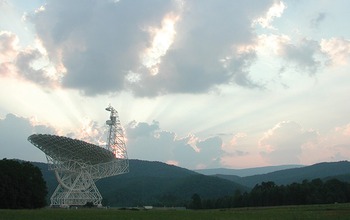Press Statement 17-009
Green Bank Observatory: NSF Releases Draft Environmental Impact Statement
Document outlines NSF’s agency-preferred alternative for future facility operations and addresses potential environmental impacts
November 30, 2017
This material is available primarily for archival purposes. Telephone numbers or other contact information may be out of date; please see current contact information at media contacts.
Richard F. Green, the National Science Foundation's division director for Astronomical Sciences, issued the following statement:
On Nov. 8, 2017, the National Science Foundation (NSF) published the Draft Environmental Impact Statement (DEIS) for the Green Bank Observatory in Green Bank, West Virginia.
NSF prepared the DEIS in compliance with the National Environmental Policy Act of 1969, as amended, to evaluate the potential environmental effects of proposed changes to operations at the facility due to agency funding constraints.
The agency-preferred path forward is detailed in Action Alternative A, which involves collaboration with interested parties for continued science- and education-focused operations with reduced NSF funding.
Action Alternative A would involve the least change to the current facility and would retain the Green Bank Telescope, other appropriate telescopes, and appropriate supporting facilities to be determined with the interested parties and by a new operating arrangement.
Green Bank Observatory conducts valuable science and education activities, and NSF has funded the facility and its research and education efforts for more than half a century. At the same time, NSF relies on the scientific community to provide input on its priorities. That community has recommended NSF divestment from the observatory, as well as from other observatories currently under similar review, in response to a constrained budgetary environment.
Those recommendations were presented in the 2012 report of the NSF Portfolio Review Committee, a commissioned subcommittee of the NSF Directorate for Mathematical and Physical Sciences Advisory Committee. The Portfolio Review Committee was charged with recommending a balanced portfolio for NSF's Division of Astronomical Sciences to maximize the science recommended by "New Worlds, New Horizons in Astronomy and Astrophysics," the 2010 National Academies sixth decadal survey in astronomy and astrophysics.
The recommendations were further endorsed by the 2016-2017 annual report of the NSF Astronomy and Astrophysics Advisory Committee, and the 2016 National Academies' mid-decadal report "New Worlds, New Horizons, A Midterm Assessment."
More information is available on the Green Bank Observatory Environmental Review site. Comments on the DEIS may be submitted to NSF through Jan. 8, 2018, via envcomp-AST-greenbank@nsf.gov or via postal mail to:
Elizabeth Pentecost
National Science Foundation
Division of Astronomical Sciences, Suite W9152
2415 Eisenhower Ave.
Alexandria, VA 22314
-NSF-
Media Contacts
Aya Collins, NSF, (703) 292-7737, email: acollins@nsf.gov
The U.S. National Science Foundation propels the nation forward by advancing fundamental research in all fields of science and engineering. NSF supports research and people by providing facilities, instruments and funding to support their ingenuity and sustain the U.S. as a global leader in research and innovation. With a fiscal year 2023 budget of $9.5 billion, NSF funds reach all 50 states through grants to nearly 2,000 colleges, universities and institutions. Each year, NSF receives more than 40,000 competitive proposals and makes about 11,000 new awards. Those awards include support for cooperative research with industry, Arctic and Antarctic research and operations, and U.S. participation in international scientific efforts.
Connect with us online
NSF website: nsf.gov
NSF News: nsf.gov/news
For News Media: nsf.gov/news/newsroom
Statistics: nsf.gov/statistics/
Awards database: nsf.gov/awardsearch/
Follow us on social
Twitter: twitter.com/NSF
Facebook: facebook.com/US.NSF
Instagram: instagram.com/nsfgov



